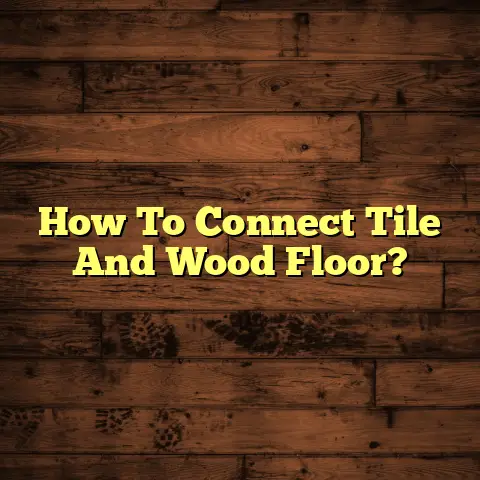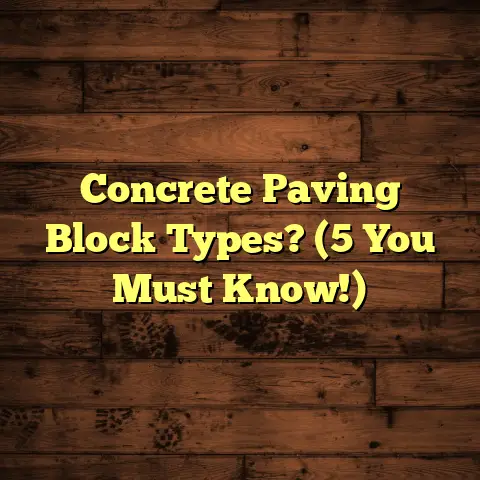Easily Remove Tile: Simple Guide (2 Hour Demo?)
I’ve seen it all when it comes to flooring, and let me tell you, nothing sparks more dread in a homeowner’s eyes than the thought of removing tile. It’s often seen as a permanent fixture, a stubborn layer that’s more trouble than it’s worth to get rid of.
But what if I told you that you could ditch that outdated or damaged tile in just a couple of hours? Sounds too good to be true, right?
Stick with me, and I’ll show you a straightforward, step-by-step method to remove tile efficiently and effectively. Whether you’re dreaming of a fresh new look, need to tackle hidden problems underneath, or are just itching for a change, this guide will give you the confidence to take on the challenge.
Why remove tile in the first place?
Well, maybe your kitchen is sporting a look that’s screaming “1980s,” or perhaps you’ve discovered a cracked tile that’s just begging to be replaced.
Sometimes, the reason is more practical – you might need to address moisture issues lurking beneath the surface, or you’re simply ready to upgrade to a different type of flooring altogether.
Whatever your reason, removing tile doesn’t have to be a monumental task. Let’s get started!
Section 1: Understanding the Types of Tile
Before we grab our tools and start swinging, it’s essential to know what we’re dealing with. Tile isn’t just tile; there’s a whole world of different materials and installation methods out there. Here’s a quick rundown of the most common types you’ll find in homes:
-
Ceramic Tile: This is your workhorse, the most common type of tile. It’s relatively inexpensive, durable, and comes in a vast array of styles and colors. Ceramic tile is porous, so it’s often glazed to make it water-resistant.
-
Porcelain Tile: Think of porcelain as ceramic’s tougher cousin. It’s denser, less porous, and more durable, making it ideal for high-traffic areas and outdoor use. Porcelain tile is often through-bodied, meaning the color runs all the way through, so chips are less noticeable.
-
Vinyl Tile: This is a popular choice for its affordability and ease of installation. Vinyl tile comes in various forms, including sheet vinyl, vinyl planks, and self-adhesive tiles. It’s water-resistant and comfortable underfoot, but less durable than ceramic or porcelain.
-
Natural Stone Tile: This category includes materials like granite, marble, slate, and travertine. Natural stone tile is beautiful and adds a touch of luxury to any space, but it’s also more expensive and requires more maintenance.
Each type of tile presents its own set of challenges when it comes to removal. Ceramic and porcelain tend to be more brittle and prone to cracking, while vinyl can be a pain to scrape up due to its adhesive backing. Natural stone can be particularly difficult to remove without damaging the subfloor.
Tools for the Job:
The tools you’ll need will vary slightly depending on the type of tile you’re removing. Here’s a general list:
- Safety Glasses: Protect your eyes from flying debris.
- Gloves: Protect your hands from sharp edges and chemicals.
- Dust Mask or Respirator: Protect your lungs from dust and mold spores.
- Tile Cutter or Score: For scoring the grout lines.
- Chisel: For breaking up the tile.
- Hammer: For striking the chisel.
- Pry Bar: For lifting the tile.
- Scraper: For removing adhesive residue.
- Shop Vac: For cleaning up dust and debris.
- Grout Removal Tool: (Optional) For removing grout before scoring.
Section 2: Preparation for Tile Removal
Okay, now that we know what we’re up against, let’s get ready to rumble! Proper preparation is key to a smooth and efficient tile removal process. Here’s what you need to do:
-
Assess the Workspace: Take a good look at the area you’ll be working in. How big is it? Are there any obstacles, like cabinets or appliances? Move any furniture out of the room or cover it with plastic sheeting to protect it from dust and debris.
-
Gear Up for Safety: This is non-negotiable. Put on your safety glasses, gloves, and dust mask or respirator. Trust me, you don’t want to breathe in tile dust or get shards of tile in your eyes.
-
Gather Your Tools: Make sure you have all the necessary tools within easy reach. There’s nothing more frustrating than having to stop mid-project to hunt down a chisel or hammer.
-
Plan Your Attack: Before you start swinging, take a moment to plan your approach. Identify any potential problem areas, like corners or edges. Think about how you’ll dispose of the old tiles.
Protecting the Subfloor:
One of the biggest concerns when removing tile is damaging the subfloor underneath. The subfloor is the foundation for your new flooring, so it’s crucial to keep it in good condition. Here are a few tips:
- Use a Sharp Chisel: A dull chisel will require more force, increasing the risk of damaging the subfloor.
- Work at a Low Angle: When using the chisel, try to work at a low angle to avoid digging into the subfloor.
- Be Patient: Don’t try to rush the process. Take your time and work carefully.
- Consider a Heat Gun: For stubborn tiles, a heat gun can help soften the adhesive, making them easier to remove.
Section 3: The Tile Removal Process
Alright, let’s get down to the nitty-gritty! Here’s a step-by-step demonstration of the tile removal process:
Phase 1: Scoring the Tile
This is a crucial step that often gets overlooked. Scoring the grout lines around each tile helps to weaken the bond between the tile and the subfloor, making it easier to remove.
- Use a tile cutter or grout saw: Carefully run the tool along the grout lines, applying even pressure.
- Don’t apply too much pressure: You don’t want to damage the surrounding tiles.
- Clean up the Dust: Use a shop vac to remove any dust or debris created by the scoring process.
Phase 2: Loosening the Tile
Now it’s time to start breaking up the tile.
- Position the chisel: Place the chisel at the edge of a tile, at a 45-degree angle.
- Strike the chisel: Use the hammer to strike the chisel firmly, but not too hard.
- Work your way around the tile: Continue chiseling around the edges of the tile until it starts to loosen.
- Be patient: Some tiles will come up easily, while others will require more effort.
Phase 3: Removing the Tile
Once the tile is loose, you can use a pry bar to lift it up.
- Insert the pry bar: Slide the pry bar under the edge of the tile.
- Apply pressure: Gently apply pressure to the pry bar until the tile starts to lift.
- Work slowly: Avoid jerking the pry bar, as this can damage the subfloor.
- Deal with Adhesive: If the tile is stuck to the subfloor with adhesive, use a scraper to remove the residue.
Phase 4: Cleaning Up
This is the least glamorous part of the job, but it’s essential for a successful outcome.
- Dispose of the old tiles: Place the old tiles in a sturdy container for disposal.
- Sweep up debris: Use a broom or shop vac to sweep up any loose debris.
- Scrape off adhesive residue: Use a scraper to remove any remaining adhesive residue from the subfloor.
- Vacuum the area: Use a shop vac to vacuum the entire area, paying close attention to the edges and corners.
Estimated Time:
So, can you really remove tile in just two hours? It depends on the size of the area, the type of tile, and your level of experience. However, with proper preparation and technique, it’s definitely achievable for a small to medium-sized room.
Section 4: Troubleshooting Common Issues
Even with the best preparation, things can sometimes go wrong. Here are some common problems you might encounter during tile removal, along with some solutions:
-
Stubborn Tiles: Some tiles just don’t want to budge. If you’re struggling to remove a particular tile, try using a heat gun to soften the adhesive. You can also try scoring the grout lines more deeply.
-
Subfloor Damage: Accidents happen. If you accidentally damage the subfloor, don’t panic. Small cracks and holes can usually be repaired with a patching compound. For more serious damage, you may need to replace a section of the subfloor.
-
Adhesive Challenges: Some adhesives are incredibly stubborn. If you’re having trouble removing adhesive residue, try using a chemical adhesive remover. Be sure to follow the manufacturer’s instructions carefully.
Here’s a table summarizing common issues and solutions:
| Issue | Solution |
|---|---|
| Stubborn Tiles | Use a heat gun to soften the adhesive. Score the grout lines more deeply. |
| Subfloor Damage | Repair small cracks with patching compound. Replace damaged sections of the subfloor for more serious damage. |
| Adhesive Challenges | Use a chemical adhesive remover, following the manufacturer’s instructions. Consider renting a floor scraper for large areas. |
| Excessive Dust | Ensure proper ventilation. Wear a high-quality respirator. Use a shop vac with a HEPA filter. |
| Uneven Subfloor | Apply a self-leveling compound to create a smooth and even surface. Consider using plywood or cement board to build up low areas. |
| Mold or Mildew | Treat the affected area with a mold and mildew remover. Ensure proper ventilation to prevent future growth. Address the source of the moisture problem. |
| Grout Hazing | Use a grout haze remover, following the manufacturer’s instructions. Scrub the affected area with a stiff brush. Rinse thoroughly with clean water. |
| Cracking New Tiles | Ensure the subfloor is properly prepared and stable. Use a high-quality thin-set mortar. Install expansion joints to allow for movement. |
| Lippage (Unevenness) | Use a tile leveling system to ensure even spacing and alignment. Carefully inspect each tile before installation. Use a notched trowel to apply thin-set mortar evenly. |
| Hollow Sounds | Remove the affected tile and re-apply thin-set mortar, ensuring full coverage. Consider using a larger notch trowel. Ensure the subfloor is properly prepared and free of debris. |
Section 5: Post-Removal Considerations
Congratulations! You’ve successfully removed the old tile. But the job isn’t quite finished yet. Here’s what you need to do after the tiles are gone:
-
Inspect the Subfloor: Take a close look at the subfloor for any damage. Repair any cracks or holes before proceeding.
-
Prepare the Surface: The subfloor needs to be clean, level, and dry before you can install new flooring. Use a scraper to remove any remaining adhesive residue, and then vacuum the entire area thoroughly.
-
Consider Self-Leveling Compound: If the subfloor is uneven, you may need to apply a self-leveling compound to create a smooth, flat surface.
-
Choosing New Flooring: Now comes the fun part! Think about the look you want to achieve and choose a flooring option that suits your style and budget.
Here are a few popular choices:
- Tile: If you like the look of tile, consider upgrading to a more modern style.
- Hardwood: Hardwood flooring adds warmth and elegance to any space.
- Laminate: Laminate is a durable and affordable alternative to hardwood.
- Vinyl: Vinyl flooring is water-resistant and easy to maintain, making it a great choice for bathrooms and kitchens.
Conclusion
So there you have it! A simple, step-by-step guide to removing tile in just a couple of hours. With the right tools, preparation, and technique, you can transform your space and achieve the look you’ve always dreamed of.
Don’t be intimidated by the thought of removing tile. Embrace the challenge, and enjoy the satisfaction of transforming your home with your own two hands. Remember, proper preparation and technique are key to a successful outcome. Now go get those tiles!





